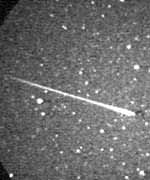NASA is moving ahead with plans to redesign a part of the Space Shuttle external fuel tank that investigators believe played a critical role in the Space Shuttle Columbia accident. The Space Shuttle program will soon begin manufacturing and installing an improved bipod fitting, which connects the external fuel tank to the Shuttle during launch.
A Critical Design Review Board of NASA managers, engineers and aerospace contractors last month approved the new design, a significant milestone in the effort to return the Shuttle to safe flight. The approval allows workers to begin incorporating the new fitting on External Tank No. 120, the tank slated for flight on the next Shuttle mission, designated STS-114.
Investigators believe that during Columbia’s launch in January 2003, insulating foam from the bipod area fell off the external tank and damaged the left wing of the Space Shuttle. The new design addresses the Columbia Accident Investigation Board recommendation to reduce the risk to the Shuttle from falling debris during liftoff. It eliminates the foam covering from the bipod fitting and replaces it with four rod-shaped heaters. The heaters will serve the same primary function as the foam, preventing ice buildup on the tank’s bipod fittings.
“This is a fix that really gets to the root of the technical problems that caused the loss of Columbia,” said Michael Kostelnik, NASA’s Deputy Associate Administrator for International Space Station and Space Shuttle Programs. “By eliminating this debris source, as well as potential debris from other areas, we are making the Shuttle a safer spacecraft.”
The External Tank Project Office at NASA’s Marshall Space Flight Center, Huntsville, Ala., first began developing redesign concepts for the bipod fitting after insulating foam from the left bipod ramp area detached during the October 2002 launch of Space Shuttle Atlantis.
The newly designed heaters will be placed below the fitting, in covers made of a strong alloy composed of nickel, chromium and iron. They will sit on top of a copper plate sandwiched between the fitting and a hard, dense material that separates the heater from the tank.
The design will be retrofitted on the 11 existing tanks and incorporated into the manufacture of all new tanks. Lockheed Martin Space Systems will do the work at NASA’s Michoud Assembly Facility in New Orleans. Delivery of the retrofitted tanks to NASA’s Kennedy Space Center, Florida, is expected in October.
For still photos on the Internet of the redesigned bipod fitting, visit:
http://www.nasa.gov/returntoflight
Video b-roll of the new bipod will air on NASA Television during the Video File segment starting at noon EDT today. Beginning July 24, NASA Television will be seen in the continental United States on AMC-6, at 72 degrees west longitude, Transponder 9, 3880 MHz, vertical polarization, audio at 6.8 MHz. If you live in Alaska or Hawaii, NASA TV will now be seen on AMC-7, at 137 degrees west longitude, Transponder 18, at 4060 MHz, vertical polarization, audio at 6.8 MHz.
For information about NASA TV, visit:
More information on NASA’s human space flight programs is available at:
Original Source: NASA News Release

